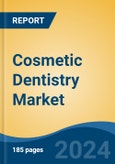Dental Veneer is the fastest growing segment, North America is the largest regional market
Speak directly to the analyst to clarify any post sales queries you may have.
10% Free customizationThis report comes with 10% free customization, enabling you to add data that meets your specific business needs.
Key Market Drivers
The Global Cosmetic Dentistry Market is primarily influenced by two significant drivers: increasing aesthetic consciousness and awareness among the general population, and continuous advancements in dental technologies and materials. Heightened aesthetic consciousness has led a growing number of individuals to seek cosmetic dental procedures to improve their smile and overall appearance.This demand is further evidenced by the active professional community focusing on enhancing esthetic dental practices. According to the International Federation of Esthetic Dentistry (IFED), in April 2024, its International Challenge, a competition showcasing talent in esthetic dentistry, involved seven countries competing in intense rounds, underscoring the widespread professional dedication to advancements in this specialized field. This robust engagement within the professional sphere reflects and supports the escalating public interest and willingness to invest in cosmetic dental enhancements.
Key Market Challenges
The inherently high cost associated with numerous cosmetic dental procedures, coupled with restrictive insurance reimbursement policies, represents a significant impediment to global market growth. These substantial financial requirements create a notable barrier to access, preventing a considerable portion of the population from pursuing aesthetic dental enhancements. Patients frequently face considerable out-of-pocket expenses, as many dental insurance plans prioritize functional restoration over elective cosmetic treatments, leading to limited or no coverage for such procedures.Key Market Trends
The expansion of tele-dentistry and remote consultations is significantly transforming access to cosmetic dental care. This trend offers virtual initial assessments, follow-up care, and specialized consultations, overcoming geographical limitations and enhancing patient convenience. Remote monitoring and timely intervention are particularly beneficial for extending care to underserved populations. According to the American Dental Association, in February 2025, a study featured on its website reported that 81.6% of children in a rural teledentistry program completed their recommended dental treatments within six months of virtual consultations, illustrating its effectiveness in improving care access. This growing adoption stems from both patient demand for flexible options and providers' capability to efficiently broaden their service reach.Key Market Players Profiled:
- Henry Schein, Inc.
- Align Technology, Inc.
- Dentsply Sirona, Inc.
- Envista Holdings Corporation
- Kuraray Co., Ltd
- Straumann Holdings AG
- Planmeca Group
- 3M Company
- Zimmer Biomet Holdings, Inc.
- Roland DG
Report Scope:
In this report, the Global Cosmetic Dentistry Market has been segmented into the following categories:By Product:
- Dental Systems and Equipment
- Dental Implants
- Dental Crowns & Bridges
- Dental Veneer
- Orthodontic Braces
- Others
By Dental Systems and Equipment:
- Instrument Delivery systems
- Dental Chairs
- Dental Handpieces
- Dental Lasers
- Dental Radiology Equipment
- Others
By End User:
- Dental Hospital & Clinics
- Dental Laboratories
- Others
By Region:
- North America
- Europe
- Asia-Pacific
- South America
- Middle East & Africa
Competitive Landscape
Company Profiles: Detailed analysis of the major companies present in the Global Cosmetic Dentistry Market.Available Customizations:
With the given market data, the publisher offers customizations according to a company's specific needs. The following customization options are available for the report.Company Information
- Detailed analysis and profiling of additional market players (up to five).
This product will be delivered within 1-3 business days.
Table of Contents
Companies Mentioned
The companies profiled in this Cosmetic Dentistry market report include:- Henry Schein, Inc.
- Align Technology, Inc.
- Dentsply Sirona, Inc.
- Envista Holdings Corporation
- Kuraray Co., Ltd
- Straumann Holdings AG
- Planmeca Group
- 3M Company
- Zimmer Biomet Holdings, Inc.
- Roland DG
Table Information
| Report Attribute | Details |
|---|---|
| No. of Pages | 185 |
| Published | November 2025 |
| Forecast Period | 2024 - 2030 |
| Estimated Market Value ( USD | $ 36.51 Billion |
| Forecasted Market Value ( USD | $ 74.02 Billion |
| Compound Annual Growth Rate | 12.5% |
| Regions Covered | Global |
| No. of Companies Mentioned | 11 |









